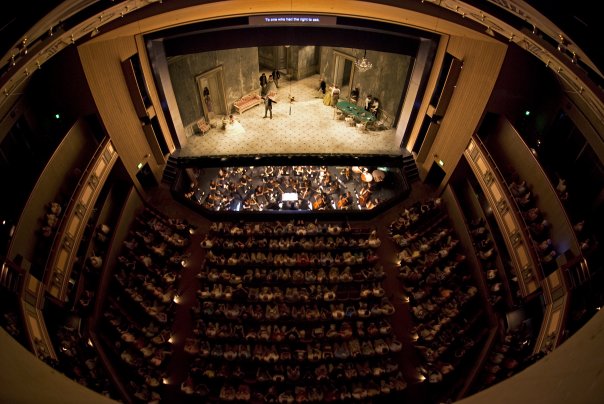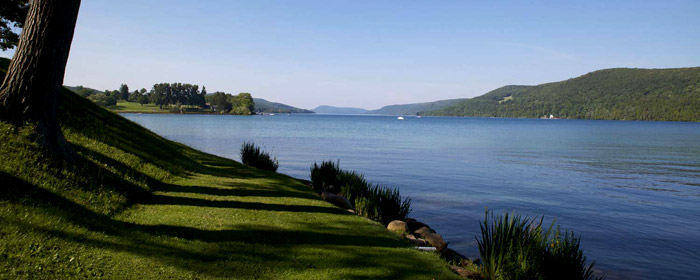
| | Organist | Accordionist | Composer | Conductor | Author | Educator |

 |
Henry Doktorski
|
 |

Accordionist Henry Doktorski with Maestro John DeMain at Glimmerglass.
July 22 to August 25, 2012: Accordionist Henry Doktorski appeared at the Glimmerglass Opera Festival in nine performances of Kurt Weill's musical "Lost In The Stars."
The Glimmerglass Festival, situated on the northwestern shore of beautiful Lake Otsego--the "Glimmerglass" of James Fenimore Cooper's Leatherstocking Tales--in Upstate New York, is one of the premiere opera summer festivals in the United States. Four productions were presented this season: Giuseppe Verdi's Aida, Meredith Wilson's The Music Man, Jean-Baptiste Lully's Armide, and Kurt Weill's Lost In The Stars.
Doktorski said, "It was certainly a highlight of my summer to perform with the Glimmerglass Opera Orchestra, under the batons of Principal Conductor John DeMain and Assistant Conductor Craig Kier. Actually, it was like a vacation for me there; besides the rehearsals and performances, I had time to enjoy the beautiful Upstate New York countryside. I visited Glimmerglass State Park, Lake Otsego, historic downtown Cooperstown, the Otesaga Resort, the Farmer's Museum, the Fenimore Art Museum, several local breweries and wineries (for tours and tastings), and even took a couple day trips into the Catskill and Adirondack Mountains. It's been a real pleasure!"
Doktorski continued, "Of course, playing in the show was definitely the high point for me. The theater was superb, as were the singers, musicians, staff and technical crew. The accordion appeared in nine numbers in this show: Train to Johannesburg, Little Tin God, Lost in the Stars, Entra'act, The Wild Justice, O Tixo Tixo Help Me, Cry the Beloved Country, Big Mole and the Finale. Registrations were not indicated by the composer, but I used the Bandoneon Stop (one low and one middle reed) for everything except Big Mole during which I used the Violin Stop (two middle reeds) to accompany the singing of a boy alto."
Maestro Craig Kier, Assistant Conductor for Lost in the Stars, spoke about Kurt Weill's use of the accordion:
Weill created an impressively diverse sound world in "Lost in the Stars," utilizing very few players (some 12) at the premiere, many of whom doubled on at least two instruments. Though the story is set entirely in South Africa, Weill used a musical language that we would respond to. Rather than trying to write his version of Zulu music, he uses the instruments in very interesting combinations to help create a world that encompasses a South African sound, while still remaining true to the Kurt Weill sound we know.
Katherine Kozak, Glimmerglass' Principal Coach and Accompanist for Lost in the Stars, spoke at length about the accordion in Kurt Weill's opera:The piano and accordion were originally written for one player - which also gives us insight to the practices of the late 1940's and early 1950's on Broadway. The accordion is used throughout the work at selective points, always bringing to life the melody or underlying chords it fills in. This writing makes the audience aware of the accordion's presence each time it's used. There are moments it acts as a harmonium, helping to fill out the orchestral sound with harmonic swells. Having played the harmonium in many works myself, I can appreciate the greater flexibility the accordion provides when used in this manner.
The use of accordion the audience is likely most aware of is its playing of solo lines (or joining others instruments in the orchestra and/or soloists on stage with the melody). In "The Train to Johannesburg," we hear the accordion's immediate presence, playing a melody that is repeated throughout. Weill's articulations and accents are very specific, and the instrument's ability to play above the orchestra at these moments perfectly compliments the dramatic picture the audience sees on stage.
As a conductor, I appreciate Weill's use of the accordion throughout the entire work and the many ways it can compliment and augment the story being told onstage. We are so fortunate to have such a fine player this season in Henry Doktorski - a few accordionists have pointed out to me that Weill's ideas for accordion were wonderful, but they are not always ideally suited for playing on the instrument. One would never know this based on the fine playing from Henry this season!
Ruth Berry, the American Federation of Musicians Union Steward and cellist in the Glimmerglass orchestra, also elaborated on the accordion's role in Lost in the Stars:
What is interesting to me about the use of the accordion in this score, is how Weill scores it to make use of the many varied colors and textures of which the instrument is capable. It has the capacity to be used both rhythmically and lyrically. It is sometimes highlighted, and sometimes used as a supporting color, in different numbers. The accordion provides strong rhythmic reinforcement in certain numbers. In "Train to Johannesburg", the drums as well as the chorus voices evoke the chugg-chugg sound of a train (at one point, towards the end of the piece, the chorus sings repeatedly "click click cluckety"). The accordion joins by playing rhythmic chords, and supports the aural imagery of a train. There is also rhythmic reinforcement in "Big Mole". This is a song in 2/4 time, right before the heavy climax of the show, where I believe Weill attempted to loosen the tension a bit. It is sung by a young boy, where he describes a toy he made himself. Here, the accordion helps with the toe-tapping and simplicity of the number. Very interestingly, is that in both the aforementioned numbers, Weill has the accordion switch back and forth between rhythmic reinforcement and melody lines. These are the only two numbers in the score in which the instrument plays prominent melody lines.
There are several other points, though, where the instrument is treated lyrically, and often plaintively. Three emotionally charged numbers use it to underline the gravity and desperation of the subject. The number which closes the first act, "Lost in the Stars", the protagonist states aloud, to himself, how he is lost emotionally after a disturbing series of events. The accordion plays rich chords sympathetically, in slow-moving harmonies. "O Tixo, Tixo, Help Me" is also sung by the protagonist, this time a prayer to God/Tixo, near the beginning of the second act. Again, the accordion supports with full-bodied chords, the harmonies often changing only one measure at a time. "Cry, the Beloved Country", the name of the novel which this piece is based, is sung by the character of The Leader and the chorus after a heavily-charged scene in a courtroom in which a death sentence is pronounced to the protagonist's only son. Again, the accordion commiserates with the gravity of the subject with mournful chords, sometimes used legato, sometimes used as punctuation.
As I play piano in the pit for this show, I have enjoyed my place next to Henry, as he plays with such expertise and personality. He is secure on the instrument and his role in the orchestra, and his competency and skillful playing are well-appreciated.
When one first glances at Kurt Weill's score to "Lost In The Stars," it seems that the accordion features prominently in only two numbers: "Train to Johannesburg" and "Big Mole." However, when we study the other seven arias and choruses in which the accordion appears, we notice something unusual and important: the accordion occupies a central and prominent position in Weill's orchestration. Weill truly had the accordion (and piano) at the heart of his composing for most of the "songs" for "Lost in the Stars." In fact, the more I hear this piece, the more it becomes obvious that the accordion is not only "central" but is actually the "soul" of Weill's orchestration. Note how the orchestra's harmonic rhythm and natural phrasing/dynamics are idiomatic of the accordion in numerous places ("Lost In the Stars" and "Cry the Beloved Country", in particular). The orchestra becomes an enhancement/expansion of the accordion; this simple yet complex instrumental voice drives the natural essence of humanity as a musical metaphor for the words written by Alan Paton and Maxwell Anderson. With each performance of this beautiful, poetic and elementally truthful work not a moment goes by that does not substantiate this conclusion. I am sure Weill scholars have observed this.
Performances were July 22, July 28, August 3, August 7, August 11, August 16, August 18, August 20 and August 25. For more information about the Glimmerglass production of Lost In The Stars, see Glimmerglass Festival 2012. Doktorski also played this work four years ago with the Pittsburgh Opera Theater. See Kurt Weill's Lost In The Stars."However--if I might add a personal story here--earlier this year there were some in Glimmerglass management who suggested purely in the interest of saving a few thousand dollars for the company to have the pianist in the orchestra play a synthesizer to imitate and replace the accordionist. As the American Federation of Musician's Union Steward for Local 443 (Oneonta, NY) at Glimmerglass I fought this proposal together with my fellow Union representatives on the principles of employment rights and artistic integrity; we insisted that the Opera have a live accordionist in the orchestra.
Aside from the musician employment concern (which is supported by AFM ByLaws pertaining to replacement of acoustic instruments by a synthesizer) I was confident that my research and advisers on the matter were correct in asserting that Weill's intention was for one person to cover both Piano and Accordion. There are versatile professionals who can move comfortably between both instruments and thus one person can cover the Piano/Accordion book. At the outset I was afraid that I might have pushed this agenda too far and that the accordion was indeed only important on two "songs"--which is how management had presented the situation to us (and thus they said that a synthesizer would be fine)--but after several performances--and reflecting upon Weill's choices of textures, harmonies, and voicings--it is not just my wishful thinking; this is one of the most rewarding successes I have experienced as Union Steward--convincing management to spend the money and hire a live accordionist. Not only was the employment of a professional musician protected from being replaced by a synthesizer; the artistic integrity of the music was also protected, giving artistic meaning to the contract language "The Opera agrees to hire additional musicians as required by the original score."
I believe it would be impossible for a synthesizer player, however skilled, to perfectly reproduce the timbre, presence, subtle shadings of tone, sensitive phrasings, and the magnificent crescendi and decrescendi which Doktorski coaxes out of his instrument. The accordion truly breathes in his hands. It is a pleasure for me, as a cellist in the orchestra, to hear him play in our orchestra during this production.
To read a review of Lost In The Stars from the Ithaca Times, see Lost in the Stars Is a Moving Glimmerglass Experience.
A video interview with Lost In The Stars director Tazewell Thompson and Glimmerglass Opera General Director Francesca Zambello appeared in Upstate Opera Explores Fight Against Apartheid. Doktorski's accordion can be heard in the clip from the opening night performance at 5:25.

The accordionist in the pit... Photo by Gina Mazza.

The accordionist is situated between the piano & harp players... Photo by Gina Mazza.

Doktorski and DeMain... Photo by Gina Mazza.

The Alice Busch Opera Theater at Glimmerglass... Photo by William Brown.

The Alice Busch Opera Theater... photo by William Brown.

The theater interior... photo by Peyton Lea.

The theater interior...

New York State Route 80.

Otsego Lake.
For booking information and teaching inquiries
see Contact Henry Doktorski.
Back to The Homepage of Henry Doktorski